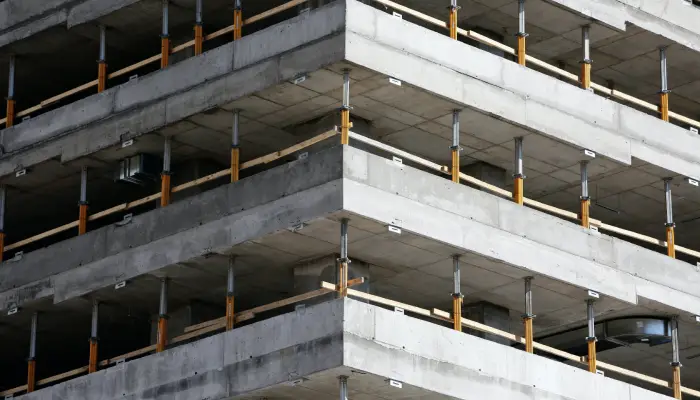
1. O que é concreto e como ele é feito?
O concreto é a segunda commodity mais utilizada no planeta. Inclui principalmente cimento, agregados (agregados finos e agregados grossos), aditivos (éter de celulose, fibra...), água e aditivos (pigmento, plastificantes...). Como na figura a seguir. Atualmente, ele é um material indispensável no setor de construção. As empreiteiras de concreto também estão em ascensão em todo o país.

1.1 O cimento é um dos ingredientes do concreto.
É como a farinha para fazer pão. É o ingrediente mais caro.
Essa é a terminologia para misturas comumente feitas com cimento;
1) Colar é quando você pega cimento e adiciona água. É como uma cola que mantém tudo unido.
2) Cimento, água e areia formam um Argamassa ou rejunte. A areia também é conhecida como agregado fino.
3) Para fazer ConcretoSe você não tiver um ingrediente específico, precisará de mais um ingrediente: água, areia e pedra, cascalho ou rochas. As rochas também são conhecidas como agregado grosso.
1.2 Aditivos ou qualquer outra coisa que você adicionar à mistura.
A mistura para concreto pode ser uma forma de produto químico ou mineral que você adiciona. Em geral, é um material em pó ou líquido. As razões para adicionar aditivos ao concreto são que eles podem trazer algumas propriedades que o concreto não tem, como durabilidade, resistência à corrosão, trabalhabilidade... Os melhores aditivos são os retardadores e os aceleradores.
1.2.1 Quais são os tipos de aditivos para concreto?
1. Superplastificante
2. Adjuvante de controle de ar
3. Aditivos retardadores
4. Misturas para impermeabilização
5. Redutor de água
6. Aditivos formadores de gás.
7. Aditivos aceleradores
8. Misturas que reduzem a segregação e modificam a viscosidade
9. Adjuvantes redutores de retração
10. Adjuvantes de dispersão de polímeros
11. Misturas de argamassa prontas para uso
12. Aditivos para concreto projetado
13. Adjuvantes de ligação
14. Adjuvantes de rejuntamento
15. Aditivos inibidores de corrosão
16. Adjuvantes de coloração
17. Auxiliares de bombeamento
1.3 Agregados
Para criar uma estrutura durável, você precisa adicionar agregados. Os agregados fazem muitas coisas. Eles restringem o encolhimento (impedem a mudança de forma com o tempo), restringem rachaduras e são muito mais baratos do que o cimento.
70-80% dos concretos são feitos de agregados. Os agregados podem ser classificados em dois tipos Agregados finos e Agregados grossos. Agregado fino é um agregado menor do que uma peneira número 4. Sift é uma tela com um determinado tamanho de abertura. A peneira número 4 significa 4 aberturas por polegada. O tamanho de cada uma dessas aberturas é de aproximadamente 0,2 polegada. Agregado grosso é um agregado maior do que a peneira número 4. Tudo o que ficar preso na peneira número 4 será considerado agregado grosso. O tamanho máximo típico é de cerca de 1 polegada. Geralmente, são usadas pedras maiores, dependendo do local de uso.
A água é outra coisa importante porque reage com o cimento. A água deve ser limpa e livre de cloreto, pois os cloretos atacam o aço. Eles causam corrosão. Qualquer fonte de água potável pode ser usada para o beton.
1.4 Outro ingrediente para o concreto é a fibra.
As fibras ajudam a manter o concreto unido e, às vezes, são usadas como reforço. concreto reforçado com fibra estão se tornando mais populares atualmente. Há tipos de fibras como fibras de polipropileno são fibras plásticas flexíveis. Elas ajudam no estado fresco. Outra é, fibras de aço isso ajudará no estado endurecido. Isso ajuda a unir as rachaduras. Concreto de fibra de PP pode reduzir efetivamente as rachaduras no concreto.
2. Tipos de concreto
Existem classes de concreto, algumas pessoas o chamam de peso ou densidade, que é o peso do material por volume. No concreto leve, uma densidade típica deve ser < 110 LB/ft3 ou < 1760 kg/ m3. Um peso normal é de 145-150 LB/ft3 ou 2300-2400 kg/ m3. Muito raramente, você obtém um peso pesado, que é > 195 LB/ft3 ou 3100 kg/ m3.
A resistência do concreto também é chamada de resistência à compressão, que pode ser classificada em baixa, moderada e alta resistência. A resistência baixa é < 3000 PSI ou 6000 PSI ou >40 MPa.
Uma das principais chaves para a resistência do concreto é a relação W/cm, que significa água sobre cimento ou aglutinante. Para obter essa relação, o intervalo é de 0,4 a 0,6 W/cm. Antes, a resistência era uma das principais medidas da qualidade do beton, mas agora ele também deve ser durável, construível e forte.
Além da resistência à compressão, há outras que medimos. A resistência à compressão é de 4000 PSI ou 28 MPa. A resistência à tensão é cerca de dez por cento da resistência à compressão (400 PSI) ou 2,8 MPa. A resistência à flexão é igual a 7,5 da raiz quadrada da resistência à compressão, que é igual a 475 PSI, 3,3 MPa. A resistência ao cisalhamento é igual a quatro vezes a raiz quadrada de F prime c ou 0,6 da resistência à tensão. Como podemos ver em tudo isso, o concreto é fraco em tensão e forte em compressão.
3. O concreto como arma secreta.

É considerado excelente porque é feito de materiais locais, pode ser moldado em qualquer formato, usa materiais reciclados e é muito resistente.
4. O concreto está em toda parte.
Quando você olha ao seu redor, pode ver prédios, casas ou até mesmo estradas. Essas coisas são feitas de concreto. Precisamos de concreto construível, econômico, durável e sustentável, e é isso que estamos procurando.


Deixe uma resposta